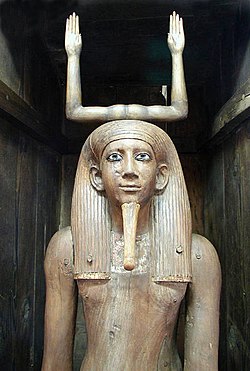Ka
| Ka in hieroglyphs | |||
|---|---|---|---|
K3 | |||

The Ka is described in the Egyptian mysteries as a luminous, bodiless double of the human being, which accompanies him throughout his life as a life-giving guardian spirit. It corresponds to the etheric body as described by Rudolf Steiner. The Ka was symbolically represented by two bent arms on the head of the person to be protected, which at that time still corresponded to an imaginatively perceivable reality. In Egyptian times, individual parts of the etheric head were not yet so firmly bound to the physical head and could rise like etheric hands into the surrounding etheric world. This ability was not lost until the Greco-Latin cultural epoch. In Egyptian hieroglyphs, the word Ka is also written with two arms pointing upwards. Closely connected with Ka was Ren, the name of man.
Man's sinister double, which appears as an image of his still untransformed bad qualities, is bound to the Ka.
„The man who put his double out of himself was called the "Kha-man" in the ancient Egyptian mysteries. The double is chained to the Kha-man to remind him continually of what his former life was like or what he still is like.“ (Lit.:GA 266b, p. 274f)
According to the Egyptian view, the Ka remained near the corpse after death in order to protect the dead and to help him to an existence in the afterlife that was appropriate to his social rank acquired in earthly life. As a dwelling place, a statute was erected for the Ka in the tomb and food and drink were provided as offerings for him[1]. The pharaohs had several Kas and for the time of the Old Kingdom several Kas are not uncommon even in private tombs.
In the Ka, i.e. in the etheric body, the memory of the past life on earth is preserved. The etheric heart, which provides information about the moral quality of the earthly life, is of particular importance. Here, at the same time, the forces are preparing themselves which, in the next incarnation, will help to determine the outer life or our deeds as karmic predispositions. That is why Anubis puts the heart of the deceased on a scale and weighs it against a feather of Maat, who is the goddess of justice. Thot noted the result and reported it to Osiris, who is the chief of the 42 judges of the dead. If the heart is heavier than the feather due to earthly transgressions, the dead person is devoured by the crocodile-headed Ammut and thus suffers the second death, through which he cannot live on as an independent personality in the afterlife. If, however, the heart is lighter or just as heavy as the feather, Horus, with the Anch sign in his hand as a symbol of eternal life, leads the dead person to Osiris, who grants him further ascent into the world beyond.
Literature
- Rudolf Steiner: Aus den Inhalten der esoterischen Stunden, Band II: 1910 – 1912, GA 266/2 (1996), ISBN 3-7274-2662-4 English: rsarchive.org German: pdf pdf(2) html mobi epub archive.org
 |
References to the work of Rudolf Steiner follow Rudolf Steiner's Collected Works (CW or GA), Rudolf Steiner Verlag, Dornach/Switzerland, unless otherwise stated.
Email: verlag@steinerverlag.com URL: www.steinerverlag.com. Index to the Complete Works of Rudolf Steiner - Aelzina Books A complete list by Volume Number and a full list of known English translations you may also find at Rudolf Steiner's Collected Works Rudolf Steiner Archive - The largest online collection of Rudolf Steiner's books, lectures and articles in English. Rudolf Steiner Audio - Recorded and Read by Dale Brunsvold steinerbooks.org - Anthroposophic Press Inc. (USA) Rudolf Steiner Handbook - Christian Karl's proven standard work for orientation in Rudolf Steiner's Collected Works for free download as PDF. |
References
- ↑ This elaborate care of the grave, however, was only possible for members of the upper class.
